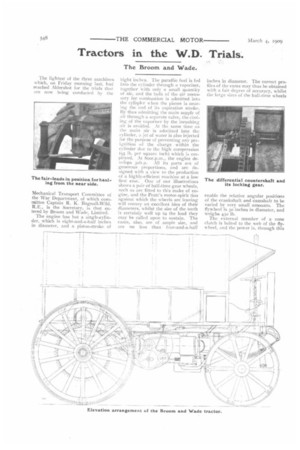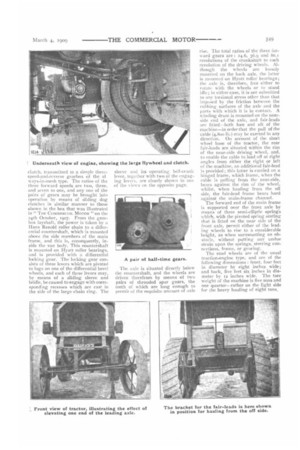Tractors in the W.D. Trials.
Page 16

Page 17

If you've noticed an error in this article please click here to report it so we can fix it.
The Broom and Wade.
The lightest of the three machines which, on Friday morning last, had reached Aldershot for the trials that are now being conducted by the
Mechanical Transport Committee of the War Department, of which committee Captain R. K. Bagnall-Wild, RE., is the Secretary, is that entered by Broom and Wade, Limited.
The engine has but a single-cylinder, which is eight-and-a-half inches in diameter, and a piston-stroke of
'eight inches. The paraffin fuel is fed into the cylinder through a vaporiser, together with only a small quantity of air, and the bulk of the air necessary for combustion is admitted into the cylirider when the piston is nearing the end of its aspiration stroke. By thus admitting the main supply of air through a separate valve, the cooling of the vaporiser by the inrushing air is avoided. At the same time as the main air is admitted into the cylinder, a jet of water is also injected for the purpose of preventing any preignition of the charge within the cylinder due to the high compression (95 lb. per square inch) which is employed. At Soor.p.m., the engine de
velops 3oh.p. .111 its parts are of generous proportions, and are designed with a view to the production of a highly-efficient machine at a low first cost. One of our illustrations shows a pair of half-time gear wheels, such as are fitted to this make of engine, and the Pratt's motor-spirit tins against which the wheels are leaning will convey an excellent idea of their diameters, whilst the size of the teeth is certainly well up to the load they may be called upon to sustain. The cams, also, are of ample size, and are no less than four-and-a-half inches in diameter. The correct profiles of the cams may thus be obtained with a fair degree of accuracy, whilst the large sizes of the half-time wheels enable the relative angular positions of the crankshaft and camshaft to be varied by very small amounts. The flywheel is 30 inches in diameter, and weighs 430 lb.
The external member of a cone clutch is bolted to the web of the flywheel, and the power is, through this clutch, transmitted to a simple threespeed-and-reverse gearbox of the al ways-in-mesh type. The ratios of the three forward speeds are two, three, and seven to one, and any one of the pairs of gears may be brought into operation by means of sliding dog clutches in similar manner to those shown in the box that was illustrated in " THE COMMERCIAL MOTOR "On the 24th October, i9o7. From the gearbox layshaft, the power is taken by a Hans Renold roller chain to a differential countershaft, which is mounted above the side members of the main frame, and this is, consequently, inside the van body. This countershaft is mounted on Hyatt roller bearings, and is provided with a differential locking gear. The locking gear consists of three levers which are pivoted to lugs on one of the differential bevel wheels, and each of these levers may, by means of a sliding sleeve and bridle, be caused to engage with corresponding recesses which are cast in the side of the large chain ring. The
sleeve and its operating bell-crank lever, together with two of the engaging levers, are clearly shown in one of the views on the opposite page.
The axle is situated directly below the countershaft, and the wheels are driven therefrom by means of two pairs of sltrouded spur gears, the teeth of which are long enough to permit of the requisite amount of axle
rise. The total ratios of the three forward gears are : 24.6, 36.9 and WI revolutions of the crankshaft to each revolution of the driving wheels. Although the wheels are loosely mounted on the back axle, the latter is mounted on Hyatt roller bearings; the axle is, therefore, free either to rotate with the wheels or to stand idle ; in either case, it is not submitted to any torsional stress other than that imposed by the friction between the rubbing surfaces of the axle and the parts with which it is in contact. A winding drum is mounted on the nearside end of the axle, and fair-leads are fitted—kith fore and aft of the machine—in order that the pull of the cable (4,Soo lb.) may be exerted in any directicin. On account of the short wheel base of the tractor, the rear fair-leads are situated within the rim of the near-side driving wheel, and, to enable the cable to lead off at right angles from either the right or left of the machine, an additional fair-lead is provided ;.this latter is carried on a hinged frame, which frame, when the cable is pulling from the near-side, bears against the rim of the wheel, whilst, when hauling from the off side, the fair-lead frame bears hard against the main-frame channel.
The forward end of the main frame is supported over the front axle by means of three semi-elliptic springs ..vhich, with the pivoted spring seating that is fitted on the near side of the front axle, permit either of the leading wheels to rise to a considerable height, as when surmounting an obstacle, without putting any undue strain upon the springs, steering connections, frame, or gearing.
The road wheels are of the usual traction-engine type, and are of the following dimensions : front, four feet in diameter by eight inches wide; and back, five feet six inches in diameter by 12 inches wide. The tare weight of the machine is five tons and one quarter—rather on the light side for the heavy hauling of eight tons.
























